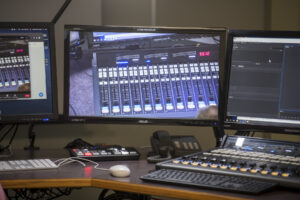Submitted by Leigh Robert/Part-Time Instructor, Broadcasting – Radio
How does a practical, lab-based program like broadcasting adapt to online learning? With some ingenuity and strong teamwork.
When all post-secondary schools went into lockdown in March 2020, Fanshawe quickly adapted to online learning for all programs. Faculty were offered weekly online training seminars to adapt their curriculum to online delivery using Virtual Classroom (Bongo) and Zoom software.
Fanshawe’s licensed radio station, 106.9 The X (CIXX-FM), needed to be on air, so second year students were given the equipment required to do their practical labs from the safety of their homes. Announcers and newscasters were supplied with microphones; producers, sales staff and writers had access to specialized software and equipment to continue the daily operations of the radio station.
As a result, students were able to complete most of their courses without losing the semester. When the lockdown was lifted and students and staff were permitted back on campus under strict COVID protocols, the remaining practical work was completed before August.
Over the shorter-than-usual summer break, technologist Josh Chesney worked tirelessly with program coordinator Abe Kelledjian to create an instructional set-up that would best mimic in-class learning for practical labs for the fall 2020 semester.
 A switcher system was installed in both teaching studios, using Blackmagic Design’s ATEM Mini switcher, to allow professors the ability to demonstrate practical board work to students. Under this set up, a computer is used to stream the in-class meeting over Zoom while another computer is used to stream content to the students.
A switcher system was installed in both teaching studios, using Blackmagic Design’s ATEM Mini switcher, to allow professors the ability to demonstrate practical board work to students. Under this set up, a computer is used to stream the in-class meeting over Zoom while another computer is used to stream content to the students.
Classes begin with a Zoom meeting using the webcam on the production computer and we can easily jump to an overhead camera to demonstrate board work or one of two production computers for content presentation. This allows us to demonstrate production techniques, answer questions and prepare the students for independent practice, just like we would in class. As an added benefit, by recording the Zoom meetings we are able to edit out the demonstrations to create a valuable resource for students that they can refer to at a later date.
All content is processed through the board, so continuous learning can take place. Students then schedule independent time in the classroom studios to practice their assignments.
Health and safety protocols must be followed; each student has their own set of headphones and mic socks and are required to use sanitizing wipes to clean the equipment before and after each use.
Fanshawe’s Radio Broadcasting program has three fully-equipped radio station studios that students learn to use just weeks after first semester begins. To manage health and safety requirements, on-air shows are staggered; students are scheduled in separate studios and transfer the board between shifts, or shifts are spread out to promote physical distancing. Students adapted quickly to the very steep learning curve and have benefitted from our approach to the blended program delivery.
Subscribe Now – Free!
Broadcast Dialogue has been required reading in the Canadian broadcast media for 25 years. When you subscribe, you join a community of connected professionals from media and broadcast related sectors from across the country.
The Weekly Briefing from Broadcast Dialogue is delivered exclusively to subscribers by email every Thursday. It’s your link to critical industry news, timely people moves, and excellent career advancement opportunities.
Let’s get started right now.




